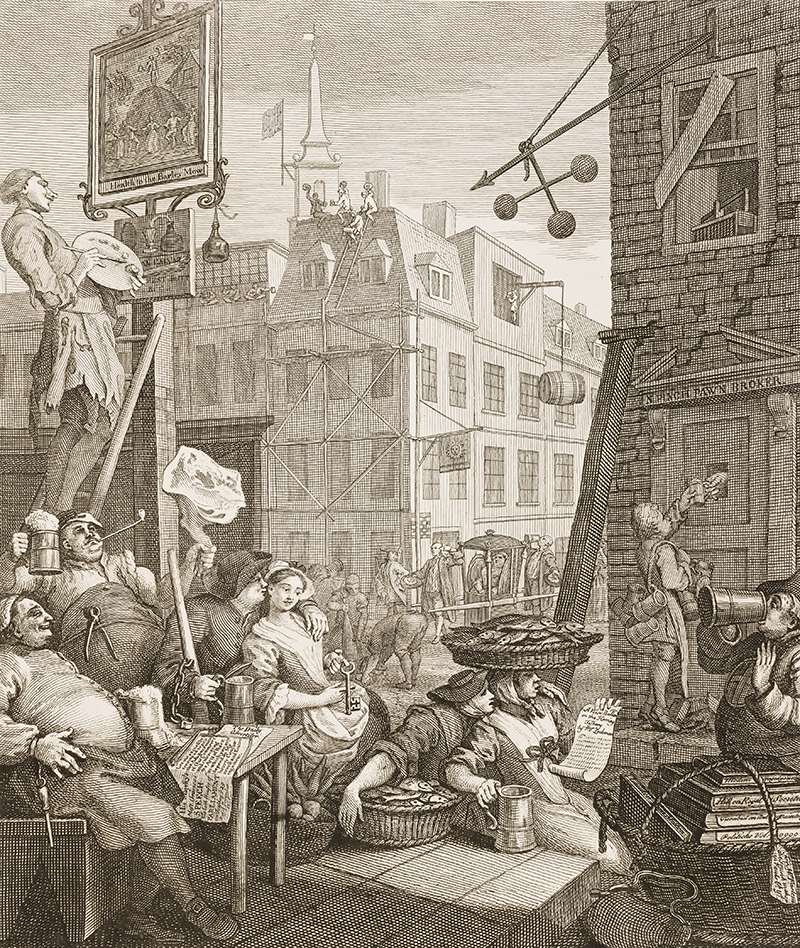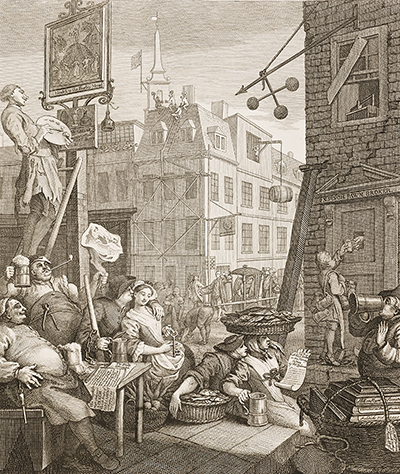Beer Street is one of a pair of prints, the other being Gin Lane, which William Hogarth produced in 1751. They were both responses to the government’s inadequacy in tackling the social and health issues caused by excessive gin drinking.
From the late 1600s onward, English, and subsequently British, governments had promoted distilling as a means to raise revenue, only half-heartedly tackling the social issues that this policy caused by bringing in the Gin Act of 1736. This was supposed to control distilling through high taxes and allegedly strict licensing, but it was mostly ignored. When it was enacted, Londoners rioted, smashing windows and attacking coaches. The high duty was abolished just seven years later. Drinking gin had never stopped. It had simply gone underground, literally in some cases, like the “Gin Royal” drinking den in a cellar in Hogarth’s “Gin Lane” print. What was required was effective legislation to bring the abuses to an end, which finally happened in 1751.
Beer Street shows London as it should be, according to Hogarth. In Beer Street, happy, hard-working citizens drink good English ale like their ancestors. A central figure is the mighty blacksmith reclining on the left, foaming mug in hand. His trade recalls Handel’s famous “Harmonious Blacksmith”, a musical hit of a few decades later. The myth has it that this piece of music was inspired by the harmonious sounds which a blacksmith was making on his anvil while Handel was listening nearby. This does appear to be simply a tale. Interestingly, however, it has been suggested that the music of Handel had the effect of “sobering up” a century in which alcoholic and other excesses had led to the ruin of many. An even older legend describes how the Greek philosopher Pythagoras learned about tuning by listening to a blacksmith's variously weighted hammers striking metal. The blacksmith therefore suggests "harmony".
The blacksmith figure in Beer Street is also sometimes interpreted as a cooper, a man whose work would involve making barrels for beer. This, like blacksmithing, is seen as an honest trade with ancient roots. He contrasts with the shady underworld figures who were often involved in gin distilling, many of whom would cut their products with unpleasant and even dangerous substances. Whether cooper or blacksmith, the Beer Street character radiates security, authority and contentment.
The blacksmith is an important character in both versions of the Beer Street print that were produced. In the earlier version, the man shows his strength by hoisting a passing Frenchman effortlessly into the air. The blacksmith’s rotund companion, a butcher, chuckles at his side as he watches. In the later version, the Frenchman has been replaced by a huge joint of meat which is equally amusing to the butcher. Both versions recall Hogarth’s painting "The Gate of Calais", which also goes by the title of "O the Roast Beef of Old England". There is a particularly nationalistic quality to the original image of Beer Street, with the clearly identifiable Frenchman dangling in mid-air. Replacing it with a leg of meat reduces the overtly anti-French sentiment. While in Calais in 1748, Hogarth had been arrested as a spy. His “Gate of Calais”, which depicts a servant carrying a large side of beef to a Calais inn, is often viewed as his revenge on his jailors. As the beef is carried along, a stereotypically fat friar licks his lips while he tries to get his hands on it, while two starving French soldiers eating from bowls of disgusting gruel gaze longingly at the good meat as it passes them by. An Irish mercenary with a firearm looks as though he is about to commandeer it, while a defeated Jacobite sits in a dejected fashion in a dark corner contemplating his fate. This, like Beer Street, is intended to promote the idea of “merry England”, in contrast to the condition of other nations.
A further difference between the two Beer Street versions is the addition of the courting couple, the paviour, or drayman, and his lass, a housemaid. In the second, they occupied the space originally filled by the Frenchman in the first version. In both versions, there are a pair of herring girls who are drinking ale and singing the words of “A New Ballad on the Herring Fishery”. On the rooftop of a pub, the roofers raise their beer mugs to their fellow workers, the tailors seated cross-legged in a nearby window. Hogarth has chosen a most auspicious, celebratory and above all, English, day to convey his meaning; it is the birthday of King George II. Everywhere there are foaming mugs and the message is clearly one of health, wealth and prosperity for the nation. Only two figures in the scene are not overtly celebrating, and they are enigmatic ones: the first is the sign painter at work on his ladder under that most English of pub signs, the Barley Mow. The second is a stout and wealthy woman stuck in a sedan chair while her two bearers stop for a drink. She is vaguely reminiscent of the “fallen woman” in Gin Street; can it be that between the two images is a coded message that warns the middle class spectator “you may have wealth, but how was it obtained? Here but for the grace of God, go you”?
As in Gin Street, the daily life of Beer Street is underscored by a poem by the Reverend James Townley, this time extolling the virtues of the health-giving drink that rivals the “Cup of Jove”. Hogarth and his fellow campaigners were not against drinking. They were opposed to the government’s attitude to gin-drinking and its refusal to take responsibility for the consequences of inaction. Hogarth’s intention was that people would buy his pair of prints as a reminder of their moral duty. Pricing them at only one shilling, he claimed that he hoped the “lower Class of People”, those who were suffering the most from the phenomenon known as the “Gin Craze” would benefit from them. However, it is just as likely that it was intended to shock the middle classes and elite who had profited from revenues through a combination of active government policy followed by government inactivity. Parliament had even banned the import of French wines in order to encourage the sale of spirits.
Beer Street was intended to be the first of the images that buyers saw. Once primed with the concept of the wholesomeness of Beer Street, the shocking images of Gin Lane would have even greater impact. The pawnbroker in Beer Street can scarcely stay in business, while the pawnbroker in Gin Lane flourishes. Hogarth’s two prints are as much about a state of mind as reality. Which are you, he asks the viewer; chaotic, debauched and selfish Gin Lane, or convivial, industrious and freedom-loving Beer Street?





